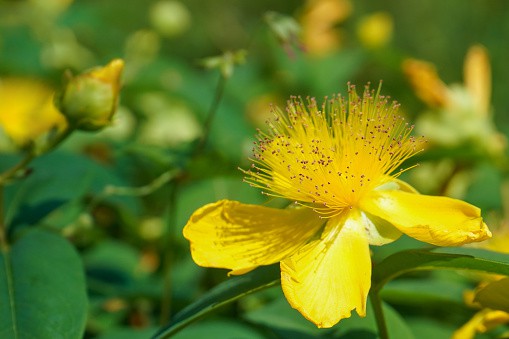If you’re looking to add a carpet of golden sun to your garden from summer to fall, look no further than this semi-evergreen shrub. It produces so many blooms that it almost covers the foliage entirely. The flowers are rose-like and have bushy stamens topped with red anthers, adding striking beauty to any landscape. It is a popular option for borders and ground cover.
Hypericum Calycinum, commonly known as St. Johns Wort, belongs to the Clusiaceae family and is classified as a perennial. The genus name Hypericum is derived from the Greek words “hyper” and “eikon” meaning “over” and “a picture”, in allusion to the traditional use of herbal medicines that were placed over holy pictures to ward off evil. In contrast, the species name Calycinum comes from the Latin “Calyx”, referring to the cup-shaped calyx, which are the sepals of the flower.
How to Plant
Due to its vigorous growth, the St. Johns Wort can tolerate a variety of light, soil, and water conditions. In general, these plants like to be in areas of full sun to partial shade; they like soil that is moist and well-draining; they also benefit from regular watering and fertilizing. The ideal temperature range for this plant is 65 to 75°F, and it is important to provide some level of humidity around the plant.
When potting, use large containers that have drainage holes and fill them with a combination of potting mix and compost. When it comes to repotting, be sure to use larger containers and lightly prune the roots before repotting. Also, use a soil mix of peat moss, perlite, and well-rotted manure.
Meaning and Symbolism
St. Johns Wort is associated with protection, paranormal activities and mental healing. It is commonly known as “Balsam” or “Balaam”, which is a reference to its healing and protective properties.In the Christian tradition, St. John’s Wort was said to have grown in the Garden of Gethsemane, the traditional location of Jesus’s prayer of agony. It was thought to have mystical and magical powers.
The flower of St. John’s Wort is known as the “flower of happiness”, symbolizing good luck and wishes. In some cultures, the flower has been used to ward off evil spirits or bring luck in love and joy. The flower is also considered to be a sign of protection and joy, making it a popular flower for gifting.
History, Mythology, and Religious Significance
St. John’s Wort has been used for centuries in the form of tinctures, teas, and oils. It was believed to have healing properties and was also known for its anti-inflammatory, anti-anxiety and anti-depressant effects. It is also believed to be “holy medicine” and is mentioned in Greek mythology and referenced in the Bible.
In ancient times, it was known as ‘St. John’s Herb’ and was believed to be a cure for many ailments including depression, suicidal thoughts and psychosis. Traditionally, it was used by shamans, monks and healers to help treat and protect those suffering from the plague and other diseases. St. John’s wort was also used in rituals and ceremonies as it was believed to have spiritual powers. In Christianity, it is associated with St. John the Baptist and it is believed to be one of the plants mentioned in the Bible as having been used to embalm and anoint Jesus’ body as he laid in the tomb.
Flower Varieties and their Defining Characteristics
The genus Hypericum consists of around 400 species of plants and many have been cultivated and hybridized. There are many varieties of St. John’s Wort, which can be separated into two main groups: the upright varieties and the spreading varieties
Upright varieties that can be found in temperate regions include Hypericum Calycinum (also known as rose of Sharon), Hypericum Perforatum (StJohnwort) and Hypericum Hypericoides (Klamath weed). These plants are usually 1-2 feet tall, with yellow blooms and airy stems.
Hypericum Calycinum, also known as Rose of Sharon, is a deciduous shrub and one of the most popular plants in the genus. The plant has bright golden yellow flowers, densely clustered and growing up to 4 inches across. The foliage is delicate, dark green. The flowers attract bees and hummingbirds, and the blooms can last from late June through September.
Hypericum Perforatum, commonly known as StJohn’s Wort, is a perennial herb and grows in more temperate areas. The foliage is a dense mound of lance-shaped leaves that are dark green in color. The yellow flowers are about an inch across. The plant is drought tolerant and can grow to about three feet tall.
Hypericum Hypericoides, sometimes known as Klamath weed, is an evergreen shrub with yellow-green fragrant blooms and silvery-green leaves. The flowers are 1.5 inches wide and the shrub can grow 3-5 feet tall. This variety is hardy to 14°F and is popular as a garden plant in cooler climates.
How to Pot and Repot
St. Johns Wort should be potted in slightly acidic, well-draining soil and placed in an area that receives full sun to part shade. When potting, use a pot that has at least one drainage hole. Fill the pot with a combination of potting mix and compost and make sure to water it thoroughly once you have finished potting. It is important to repot the St. Johns Wort every two to three years, as the plant needs a healthy root system to thrive.
When it comes to repotting, first use larger containers and then lightly prune the roots before repotting. After this has been done, use a soil mix of peat moss, perlite, and well-rotted manure. Also, be sure to water the repotted St. Johns Wort thoroughly and make sure the soil is soft and moist, but never soggy.
How to Prune
St. Johns Wort should be pruned at least once a year to encourage healthy growth and flower production. Pruning should begin in late winter by removing any dead branches and removing any crowded stems or foliage in order to increase air circulation. All of the pruned branches should be mulched and then the shrub should be lightly fertilized. In the summer, deadhead any spent flowers in order to encourage more blooms.
It is also important to prune your St. Johns Wort in order to keep it from growing too tall. Depending on the growing conditions, the shrub can grow 3-5 feet tall, so it is important to prune it to the desired height. This should be done by cutting off the vertical branches that are growing too tall. However, be sure to leave enough of the branches intact so that the plant will get sufficient sunlight and airflow.
How to Propagate
St. Johns Wort can be propagated easily through softwood and hardwood cuttings or root divisions. Softwood cuttings should be taken in late spring or early summer when the plant is actively growing, while hardwood cuttings should be taken in mid to late fall when the plant is in its dormancy period.
Root divisions should be done in the spring when the plant is in the active growth stage. To do the process of root division, first dig around the plant and loosen the soil. Then gently lift the plant up from the ground and divide the root system into sections. Replant each section in a prepared bed, keeping the soil moist and fertilized until the new plants are established.
Common Pests and Diseases
St. Johns Wort is mostly resistant to common pests and diseases and is easy to care for. However, it can be affected by root rot, powdery mildew, and leaf spot. To reduce the risk of these diseases, avoid over-watering and prune diseased foliage as soon as possible. St. Johns Wort can also be impacted by aphids, scale, and whitefly. To control these pests, use an insecticidal soap.
Three Frequently Asked Questions about Hypericum Calycinum
Q: What is Hypericum Calycinum?
A: Hypericum Calycinum, also known as St. Johns Wort, is a flowering plant in the genus Hypericum and belongs to the Clusiaceae family. It is a popular garden plant, known for its yellow flowers and ability to tolerate a wide range of conditions.
Q: How to care for Hypericum Calycinum?
A: When it comes to caring for Hypericum Calycinum, it should be planted in an area that receives full sun to part shade with moist, well-draining soil. It should also be watered and fertilized regularly and pruned once a year to remove overcrowded branches and stems. It should also be repotted every two to three years.
Q: What is the symbolism of Hypericum Calycinum?
A: The flower of Hypericum Calycinum is known as the “flower of happiness”, symbolizing good luck and wishes. In some cultures, it is also used to ward off evil spirits or bring luck in love and joy. The flower is also considered to be a sign of protection and joy, making it a popular flower for gifting.
Table Fact Sheet
| St. Johns Wort | Hypericum Calycinum |
| Family | Clusiaceae |
| Plant Type | Perennial |
| Mature Size | 3 – 5 feet |
| Sun Exposure | Full Sun to Partial Shade |
| Soil Type | Moist, Well-Drained |
| Soil pH | Slightly Acidic |
| Bloom Time | Late June to September |
| Flower Color | Yellow |
| Hardiness Zones | 5–9 |
| Native Area | Europe and Asia |
What we love from Amazon this week
Buy these wonderful flowers directly from Amazon:















